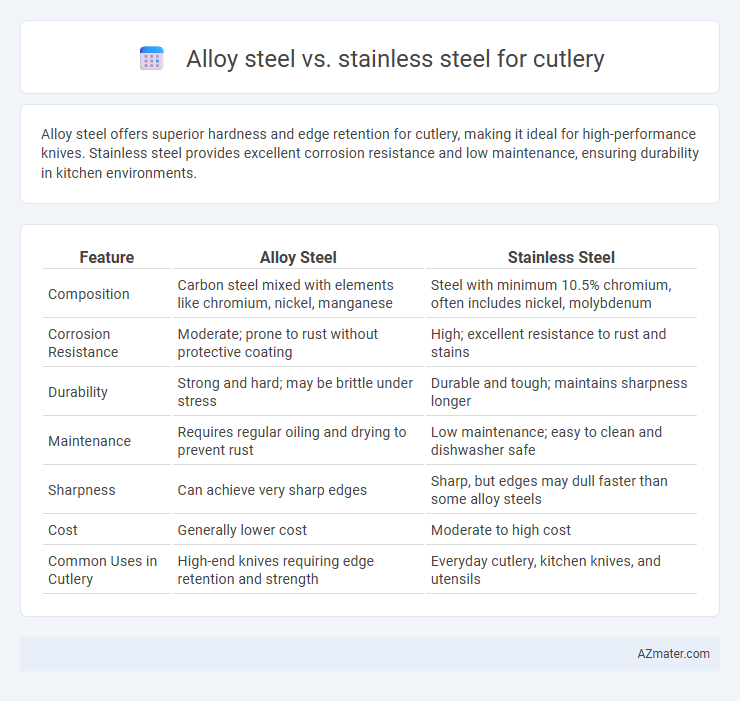Alloy steel offers superior hardness and edge retention for cutlery, making it ideal for high-performance knives. Stainless steel provides excellent corrosion resistance and low maintenance, ensuring durability in kitchen environments.
Table of Comparison
| Feature | Alloy Steel | Stainless Steel |
|---|---|---|
| Composition | Carbon steel mixed with elements like chromium, nickel, manganese | Steel with minimum 10.5% chromium, often includes nickel, molybdenum |
| Corrosion Resistance | Moderate; prone to rust without protective coating | High; excellent resistance to rust and stains |
| Durability | Strong and hard; may be brittle under stress | Durable and tough; maintains sharpness longer |
| Maintenance | Requires regular oiling and drying to prevent rust | Low maintenance; easy to clean and dishwasher safe |
| Sharpness | Can achieve very sharp edges | Sharp, but edges may dull faster than some alloy steels |
| Cost | Generally lower cost | Moderate to high cost |
| Common Uses in Cutlery | High-end knives requiring edge retention and strength | Everyday cutlery, kitchen knives, and utensils |
Introduction: Choosing the Right Steel for Cutlery
Alloy steel and stainless steel are commonly used materials for cutlery due to their durability and corrosion resistance. Stainless steel, particularly grades like 304 and 316, offers excellent rust resistance and ease of maintenance, making it ideal for kitchen knives exposed to moisture. Alloy steel, often containing carbon, chromium, and vanadium, provides superior hardness and edge retention, suited for precision cutting tools requiring long-lasting sharpness.
Alloy Steel vs Stainless Steel: Composition Differences
Alloy steel for cutlery contains a higher percentage of carbon and additional elements like chromium, manganese, and vanadium, enhancing hardness and edge retention. Stainless steel, characterized by at least 10.5% chromium content, offers superior corrosion resistance and low maintenance, making it ideal for kitchen environments. The chemical composition differences directly influence properties such as durability, rust resistance, and sharpening ease in cutlery applications.
Corrosion Resistance: Which Steel Performs Better?
Stainless steel outperforms alloy steel in corrosion resistance due to its high chromium content, which forms a protective oxide layer preventing rust and stains. Alloy steel, while potentially stronger, lacks this chromium oxide layer and is more prone to corrosion when exposed to moisture and acidic environments. For cutlery applications requiring long-lasting durability against rust, stainless steel remains the superior choice.
Durability and Strength: Key Performance Factors
Alloy steel cutlery exhibits superior strength due to its high carbon content and added elements like chromium and molybdenum, enhancing hardness and wear resistance. Stainless steel, particularly grades like 304 and 316, offers exceptional corrosion resistance while maintaining adequate strength for everyday use. For durability, alloy steel excels in edge retention and toughness, whereas stainless steel provides long-lasting resistance to rust and staining, making both materials optimal based on specific usage conditions.
Edge Retention and Sharpness
Alloy steel cutlery typically offers superior edge retention due to its higher carbon content and added elements like chromium and vanadium, which enhance hardness and durability. Stainless steel, favored for its corrosion resistance, often has a lower hardness level, resulting in quicker dulling compared to alloy steel. Sharpness in alloy steel knives is maintained longer with less frequent sharpening, making them ideal for precision cutting tasks.
Maintenance Requirements for Alloy and Stainless Steel Cutlery
Alloy steel cutlery requires regular seasoning and anti-rust treatments to prevent corrosion due to its higher carbon content and susceptibility to oxidation. Stainless steel cutlery, particularly grades with at least 18% chromium, offers superior corrosion resistance and minimal maintenance, typically needing only routine cleaning to maintain its luster. Proper care extends the lifespan of both materials but stainless steel cutlery demands less frequent attention, making it ideal for everyday use and environments with high moisture exposure.
Aesthetic Appeal and Finish
Alloy steel cutlery offers a high-quality finish with excellent hardness, allowing for sharp, precise edges and a durable, polished look that enhances aesthetic appeal. Stainless steel cutlery, prized for its corrosion resistance and lustrous, shiny surface, maintains a sleek and clean finish over time, making it ideal for visually appealing table settings. Both materials can achieve a refined aesthetic, but stainless steel's resistance to tarnish and staining often results in a longer-lasting attractive finish.
Price Comparison: Alloy Steel vs Stainless Steel Cutlery
Alloy steel cutlery typically offers a lower price point compared to stainless steel due to the use of less expensive raw materials and simpler manufacturing processes. Stainless steel cutlery contains higher percentages of chromium, nickel, and other corrosion-resistant elements, which increase production costs and retail prices. While alloy steel is more budget-friendly, stainless steel provides greater durability and resistance to rust, justifying its higher price in premium cutlery markets.
Environmental and Health Considerations
Alloy steel cutlery typically contains higher carbon content and various metals like manganese and nickel, which can lead to environmental concerns during mining and manufacturing due to energy-intensive processes and potential toxic waste. Stainless steel, especially grades like 18/10 or 304, offers excellent corrosion resistance with lower ecological impact since it is highly recyclable and less prone to leaching harmful metals into food, improving health safety. Selecting stainless steel cutlery minimizes exposure to allergens and contaminants while supporting sustainable production practices and waste reduction.
Conclusion: Selecting the Best Steel for Your Cutlery Needs
Alloy steel offers excellent hardness and edge retention, making it ideal for precision cutting tools, while stainless steel provides superior corrosion resistance and low maintenance, perfect for everyday kitchen use. Choosing between alloy steel and stainless steel depends on your specific cutlery needs, such as durability, sharpness, and resistance to rust or staining. For long-lasting sharpness and robustness, alloy steel is preferred; for ease of care and longevity in wet conditions, stainless steel is the better option.

Infographic: Alloy steel vs Stainless steel for Cutlery
 azmater.com
azmater.com